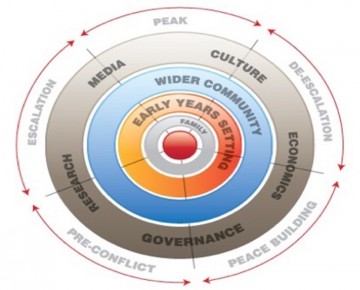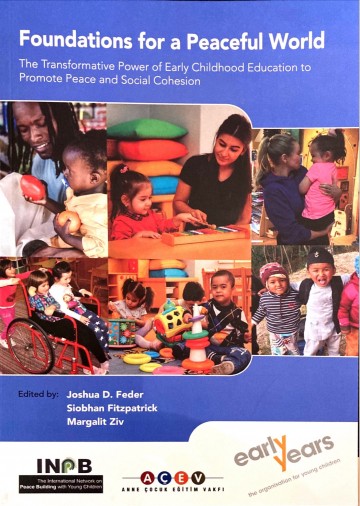Child Psychiatry at the UN: Peace Building with Young Children
Joshua D Feder, MD
Programmatic Lead, International Networking Group on Peace Building with Young Children
Co-Chair, Disaster & Trauma Issues Committee, American Academy of Child & Adolescent Psychiatry
Nine days before the most recent Middle East war, there was a moment of profound hope when, in a high-level meeting at the 78th United Nations General Assembly, IACAPAP member Josh Feder, Co-Chair of the Disaster & Trauma Issues Committee of the American Academy of Child & Adolescent Psychiatry (National Member organization of IACAPAP), gave a speech with Dr Ali Shaar, Director of the Palestinian Child Institute at An Najah National University in Nablus. The heart of their talk (13 minutes: https://nn.najah.edu/news/Alnajah-news/2023/09/28/468269/) launched a new book that advocates for the rights of children impacted by armed conflict, calling out the inanity of targeting children, and giving examples of programs across the globe that work for social cohesion and improved resilience in young children impacted by conflict.
The book, Foundations for a Peaceful World: The Transformative Power of Early Childhood Education to Promote Peace and Social Cohesion, features Dr Feder’s research on the Revised Toddler Module of the Media Initiative for Children (RTM-MIFC) addressing intersectional conflict using a scalable approach that, simply put, supports staff at toddler programs to use responsive caregiving with toddlers and helps parents and other caregivers do the same to help the children to become more resilient problem solvers and reduce the risk that they will become traumatized or radicalized over time and instead build social cohesion. Dr Feder and his team of volunteer allied professionals have developed, tested and implemented the program over the course of the past decade, demonstrating its feasibility, measurability and acceptability in a pilot study; its statistically and clinically significant efficacy for improving social emotional growth and reducing staff and caregiver stress in controlled trials; and it’s scalability to greater numbers of families and from public to private toddler care settings in Northern Ireland. The program design embeds implicit exposure of children and parents to multiple cultural and racial groups as part of the methodology for helping children become more regulated when they are upset and when staff or parents or other caregivers are supporting social emotional development during play-based interactions. The re-regulating approaches are relationship based, leaning in with empathic collaborative problem-solving vs dissembling techniques that would have carers ignore a child emotionally to compel silent compliance. The play-based support for social communication and problem-solving are derived from the evidence based Developmental Individual differences Relationship based (DIR) model of Greenspan and Wieder, simplified into a Wait-Join-Build methodology that can be taught efficiently to staff and by staff to parents and other caregivers.
How does this RTM-MIFC approach solve or prevent multigenerational conflict? The theory of change begins with increasing the capacity of adults to take time to think and reflect about how to help children to be calm and regulated in addressing the moment-to-moment challenges of social communication that form the substrate of all human interaction. This learning occurs in a nested set of reflective relationships, from the project team supporting staff to the staff supporting parents and caregivers to those parents and caregivers supporting the children, reflecting three core levels of Bronfenbrenner’s social ecological model (see figure 1). Those nested social ecological levels are themselves set into a cycle of conflict that at any time may be moving toward de-escalation and peace building or escalation and active war. In Northern Ireland there has been continuous if lower-level conflict since the 1998 Good Friday Agreement, exacerbated by Brexit with its threat of closing the border between Northern Ireland and the Republic of Ireland, leading to a subtle but definite resurgence of violence and a decreased sense of safety with its characteristic suppression of open discussion of the conflict (‘Say nothing’). So, the RTM-MIFC project labors on, focusing on the responsive caregiving aspect more than explicitly confronting the ethnic and cultural divisions. RTM-MIFC is now poised to expand to the entire country of Northern Ireland and the six border counties of the Republic of Ireland, with plans for culturally sensitive global expansion throughout the countries of the INPB.

Figure 1 (Reprinted with Permission from the International Networking Group on Peace Building with Young Children)
With different projects in multiple countries over the past two decades, the International Networking Group on Peace Building with Young Children (INPB) forms the Programmatic Subgroup for the United Nations related Early Childhood Peace Consortium, which includes luminaries in Child Psychiatry such as James Lechman and Kyle Pruett. Members representing nations in the INPB are often in conflict e.g. among Balkan states such as Serbia and Kosovo, as well as in the Middle East with members from Israel, Lebanon, and Palestine.
The recent outbreak of war in the Middle East was in its immediate impact a devastating demonstration of both the inability of peace building efforts to prevent the sudden shredding of the social fabric in the conflagration and horror and yet, after catching one’s breath, the necessity of the work to gradually build social cohesion to a point where it is much more difficult to rip apart in the storms of war.
For the past thirty years, doctors have drawn inspiration from the work of John Farmer, who travelled to far flung places to respectfully offer medical care in regions with few resources and vast suffering (read Mountains Beyond Mountains by Tracy Kidder). Child psychiatrists who choose to do work in peace building can be uniquely qualified to offer expert guidance in matters that reach across the range of biopsychosocial impacts for developing children and teens. In a world where we all want to see all guns fall silent but are powerless to make that happen immediately, much less prevent new outbreaks of violence by adults on children, peace building work is a constructive and hopeful balm for the insidious process of burnout, a voice for children who otherwise are ignored by the systems of power, and a model for others who might join the effort to protect children and build social cohesion.

(Reprinted with Permission from the International Networking Group on Peace Building with Young Children)
References:
- Bronfenbrenner, U. (2005). Ecological systems theory (1992). In U. Bronfenbrenner (Ed.), Making human beings human: Bioecological perspectives on human development (pp. 106–173). Sage Publications Ltd.
- Feder, J, Fitzpatrick, S, Ziv, M (2023) Foundations for a Peaceful World: The Transformative Power of Early Childhood Education to Promote Peace and Social Cohesion. International Networking group on Peace Building with Young Children.
- Kidder, T. (2004) Mountains Beyond Mountains. Random House Publishing.

